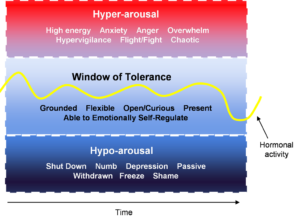WINDOW OF TOLERANCE: WHEN YOUR NERVOUS SYSTEM IS STUCK ON “ON”

All of us have a certain amount of trauma because life rarely meets our needs perfectly. More severe trauma leaves us with symptoms that interfere with our optimum functioning in life. You may not think your trauma qualifies as Post Traumatic Stress Injury (PTSI) but if your life is not functioning the way you wish it would, you most likely will benefit from seeking psychotherapy with someone trained in treating trauma.
Many of my clients with PTSI come to me and present with their nervous system in the ON position, meaning their nervous system operates mainly in the fight or flight mode. We can also be stuck on OFF but this blog post is about being stuck on ON. When I first start questioning them about their functioning, they are rarely aware that there is any other option for functioning. Normally, our nervous system has a range or window of expression and functionality in our lives. The top line represents the Sympathetic Nervous System or ON position. This is our fight or flight expression. Our minds are focused on order, things being a certain way, achieving perfection or being hyper-vigilant. If we are that way all the time, we can also have difficulty with being more aware of our inner self or allowing things into our lives. We can also have difficulty with being touched or intimacy in general. We also tend to be “walking heads” without awareness of our physical sensations or deeper, less conscious processing. Obsessive Compulsive Disorder (OCD) can also develop. Often, a person cannot relax until certain things are in order or are completed satisfactorily.
The bottom line represents the Parasympathetic Nervous System or OFF position. When balanced, we use both systems to function somewhere in the middle of the Window of Tolerance.
How do we get this way? The scenario typically is that the person was:
- The hero or perfect child of the family while others played other roles
- Sought school as a place of gaining approval with good grades
- Had a single parent with some personality challenges or one or both parents critical, not demonstrably affectionate, compromised by addiction, another sibling was the focus of parental attention, another sibling was abusive or the child was abused sexually, verbally, emotionally, physically or some combination of these types of abuse.
- Parentified – expected or forced into taking on responsibility of caring for or thinking for the parent or taking care of other children in the family, all at the expense of his/her own development.
- Had a parent with a personality disorder: I created a separate line for this because of the confusion and abuse that a parent with a personality disorder can cause.
- a) A parent can cross a child’s boundaries invasively and abusively and then withdraw suddenly for no apparent reason. Safe boundaries are so important to our mental and emotional health that they deserve a separate blog post entirely. When they are crossed without the child’s consent or control, the child grows up without a sense of safety in the world. The child can compensate by becoming controlling over his/her environment or have relatively severe attachment patterns (sudden cut offs from loved ones or friends due to an imagined slight, overly needy of others or completely disengaged from others). There are other personality disorders that qualify here such as Narcissistic Personality Disorder, etc., but one quality they all have in common is very disordered relations with others which can be profoundly damaging to children.
How do you fix this and gain optimal emotional regulation for yourself?
Psychotherapy can be extremely helpful in guiding you into functioning optimally between ON and OFF. Here are some techniques you can practice on your own.
- One thing I find helpful with all my clients and myself is regularly focusing on the present by being mindful of what is around right now. What is the temperature of the room or the air outside? What noises do you hear around you? What body sensations do you feel right now? What does the chair under you feel like? What colors do you see, what do you smell, taste and feel? These senses are also “grounding”. Don’t worry, you will fall out of this quite often. Just try to be aware and bring yourself back into the moment, especially when you feel distress.
- Vagus nerve calming techniques: Brainspotting by itself interacts with the Vagus nerve and can be calming to the nervous system. Another thing you can do is place your hand on your abdomen anywhere it feels most comforting. Then consciously breathe, imagining that you are breathing into your hand. Your Vagus nerve runs down the front of your body and is responsible for the tightening of your throat, chest or stomach when stressed. When you do controlled and conscious breathing, you calm the Vagus nerve, even more so when you focus it on your abdomen.
- Distress tolerance. When we are stuck on ON, we can be easily irritated with needing to be patient, waiting for things or by things others do which we find irritating. We can be irritated by attempts at intimacy from our loved ones, too, such as coming close, seeking hugs or just hanging out, wanting to talk as well as seeking sex. When you find yourself irritated, realize first that it is YOU, not the other person who has the problem. Try to not react negatively and stay with the uncomfortable feeling for as long as you can, even if it is for a few seconds. Remember to breathe, and you can do the abdominal Vagus nerve breathing anywhere. Be careful not to blame others or react negatively to them.
- My focus as your psychotherapist will be to guide you into being within enough of a flexible Window of Tolerance to allow Brainspotting. Brainspotting then targets the underlying trauma elegantly and efficiently so you can emotionally self-regulate and have a happy, satisfying life!
